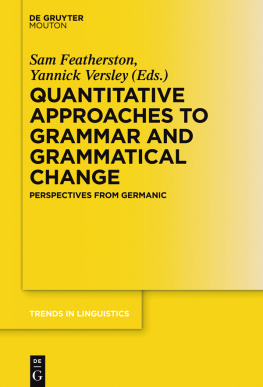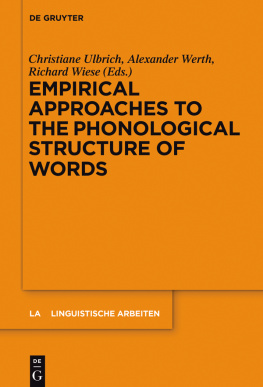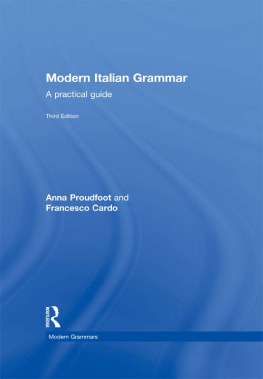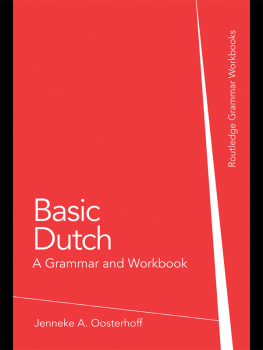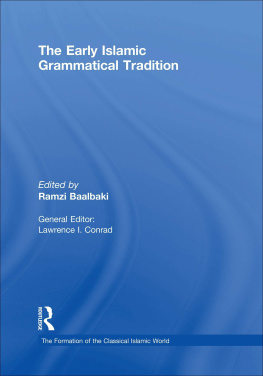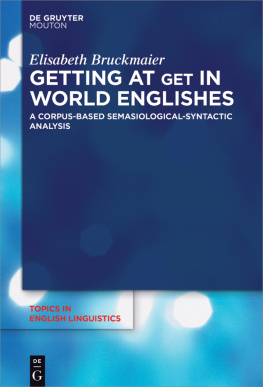Guide

Sam Featherston and Yannick Versley (Eds.)
Quantitative Approaches to Grammar and Grammatical Change
Trends in Linguistics Studies and Monographs
Editor
Volker Gast
Editorial Board
Walter Bisang
Jan Terje Faarlund
Hans Henrich Hock
Natalia Levshina
Heiko Narrog
Matthias Schlesewsky
Amir Zeldes
Niina Ning Zhang
Editors responsible for this volume
Volker Gast and Amir Zeldes
Volume 290

ISBN 978-3-11-040175-2
e-ISBN (PDF) 978-3-11-040192-9
e-ISBN (EPUB) 978-3-11-040212-4
ISSN 1861-4302
Library of Congress Cataloging-in-Publication Data
A CIP catalog record for this book has been applied for at the Library of Congress.
Bibliographic information published by the Deutsche Nationalbibliothek
The Deutsche Nationalbibliothek lists this publication in the Deutsche Nationalbibliografie; detailed bibliographic data are available on the Internet at http://dnb.dnb.de.
2016 Walter de Gruyter GmbH, Berlin/Boston
Typesetting: Compuscript Ltd., Shannon, Ireland
www.degruyter.com
Acknowledgments
We should like to thank here all of our colleagues from the research center SFB 833 Bedeutungskonstitution who have worked together with us in the production of this collection, in particular Beate Starke, who is both the brain and the heart of the centre, and Sophie von Wietersheim, Vivian Schreier, Alicia Bitzer, Sarah Becker and Hannah Gerbrich, who supported the editing process. We should also like to recognize the contribution of Wolfgang Konwitschny, who good-humouredly prevents disaster at the type-setting stage.
Sam Featherston and Yannick Versley
Introduction
There is a strong tradition in Linguistics of seeking to formulate theories on a solid basis of empirical evidence, even if this has not been quite so apparent recently. Both Chomskys (1965) insistence on using introspection as the primary source of evidence accessible to any native speaker and the subsequent preference for more objective sources of evidence that go beyond a single speaker can and should be understood as a quest for replicable, accessible and reliable evidence for hypotheses. The quest for reliable empirical evidence has since gone on to conquer many areas of linguistics without any sign of slowing, a fact that is pleasing to those among us who take the validation of linguistic theories seriously. This volume is a collection of work done by linguists who take this view and wish their work to stand on firm foundations.
One probable factor in the increasing popularity of supporting linguistic claims with quantitative evidence is the fact that the contribution of data towards theory building can vary according to the preferences of individual linguists. We may perhaps distinguish the three approaches to the relationship between quantitative data and grammatical theory in current linguistics at the sentence level: the first is data-driven linguistics, which we might characterize as being an approach which looks first at the data and attempts to describe and account for what it finds. It has the advantage of being scientific and objective in the sense that it delivers impartial generalizations, but critics might object that it forgoes the chance to obtain broader insights by trying to find merely descriptive patterns in the data.
A contrasting approach is to lay greatest weight on the development of theory. This has been most common in theoretical syntax and semantics over the last couple of decades. In this work, linguists have tended to base their claims on a very few examples with little or no effort to find external confirmation. Practioners have often characterized this work as theoretical (or perhaps formal), but we can confidently call it data-light. Critics of this approach might reproach it for being agenda-driven and seeking confirmation for positions held, rather than even-handedly seeking the truth.
A more recent position could be termed data-respecting linguistics. Colleagues taking this approach typically analyze sentence structures in theoretical models and seek to develop them, but they consider it essential to test their hypotheses empirically once they have made them. These linguists are theoretically informed and may well develop their hypotheses on the basis of theory, but they readily accept that a hypothesis is defeated if the data does not support it. They may also analyze their data with an awareness of the additional non-theoretical factors which may affect it. This approach thus marries the previously more nearly exclusive theoretical and empirical approaches.
So linguists interested in sentence structure and interpretation no longer need to choose between being theoretical or being empirical. The fact that more relationships between data and linguistics are possible means that there is room in the big tent of empirically working linguists for a wide range of different positions. The fact that data can be used to support theoretical analyses rather than replacing them has made the collection of data more attractive.
This situation also allows different fields to relate to each other. A couple of decades ago people looking at sentence form on the basis of quantitative data would have tended to produce an account in terms of processing and report it at CUNY or at AMLAP, while people taking a more theoretical perspective would have phrased their conclusions in terms of grammatical theory and take it to NELS. These two groups would have had little to say to one another. But in the light of what we feel tempted to call the empirical revolution in the study of sentence grammar, this gulf has been narrowed. Even people whose primary concern is grammatical theory take note of processing effects and attribute certain effects to them. Correspondingly, workers focusing on the surface evidence can relate more to the constructs of the theoreticians, because the two layers of explanation have been brought into contact. And these workers too must account for the data gathered by the theoreticians.
The papers in this volume are a snapshot of some of the work currently being done in this field. They vary upon this cline of data-orientation from papers such as Hofstetter and Fanselow, Hussler & Weskott at the one end to Volodina & Wei and Ruette & Speelman at the other end. Hofstetter is an example of the penetration of data into places where the quantitative approach had not previously dared to tread, namely in the semantics of measure phrases. This is some way from the work of Ruette & Speelman , who mark the other end of the spectrum, since their article very clearly starts from the available data and attempts to do something new with it, in this case with a novel analysis type Individual Differences Scaling. While these two papers are fairly distant from one another, the other papers fill up more or less all the available space between them, thus yielding a coherent grouping of evidence-based linguistic work.
There are two other parameters of difference which might be noted among the papers included here. The first is that of data type. Six of the nine report what we might term elicited data, which is mostly that from experimental procedures. Another six of the nine make use of observational data, that is, data from linguistic use which occurred spontaneously in a naturalistic context. The overlap between the groups highlights an increasing trend for linguists to correlate more than one single data source. A finding is all the more worthy of attention if the effect of interest can be identified in multiple data types.

